Contemporary Design Methods in Architecture - exhibitions ...
Contemporary Design Methods in Architecture - exhibitions ...
Contemporary Design Methods in Architecture - exhibitions ...
Create successful ePaper yourself
Turn your PDF publications into a flip-book with our unique Google optimized e-Paper software.
Inspiration<br />
<strong>Contemporary</strong> <strong>Design</strong> <strong>Methods</strong> <strong>in</strong> <strong>Architecture</strong><br />
Mark Mückenheim | Juliane Demel
Inspiration<br />
<strong>Contemporary</strong> <strong>Design</strong> <strong>Methods</strong> <strong>in</strong> <strong>Architecture</strong><br />
Mark Mückenheim | Juliane Demel
BIS Publishers<br />
Het Sieraad<br />
Postjesweg 1<br />
1057 DT Amsterdam<br />
The Netherlands<br />
T (+) 31 (0)20 515 02 30<br />
F (+) 31 (0)20 515 02 39<br />
bis@bispublishers.nl<br />
www.bispublishers.nl<br />
ISBN 978 90 6369 267 4<br />
Copyright © 2012 Mark Mückenheim, Juliane Demel<br />
and BIS Publishers<br />
All rights reserved. No part of this publication may be<br />
reproduced or transmitted <strong>in</strong> any form or by any means,<br />
electronic or mechanical, <strong>in</strong>clud<strong>in</strong>g photocopy, record<strong>in</strong>g<br />
or any <strong>in</strong>formation storage and retrieval system, without<br />
permission <strong>in</strong> writ<strong>in</strong>g from the copyright owners.<br />
Pr<strong>in</strong>ted <strong>in</strong> S<strong>in</strong>gapore
5<br />
7<br />
15<br />
31<br />
51<br />
69<br />
89<br />
119<br />
About the Book<br />
Introduction<br />
cultural significance / globalization /<br />
specific vs. generic / design methodology /<br />
digital culture / didactics / emotional<br />
decisions <strong>in</strong> design processes<br />
1 Primary Elements of <strong>Design</strong><br />
– Po<strong>in</strong>ts<br />
component assembly / po<strong>in</strong>t, l<strong>in</strong>e,<br />
surface / loss of gestalt quality / additive<br />
composition / visual effects / emergent effects<br />
2 Primary Elements of <strong>Design</strong><br />
– L<strong>in</strong>e to Surface<br />
l<strong>in</strong>es / emergent effects / optical<br />
illusions / surface composition / threedimensionality<br />
/ two-dimensional subtraction /<br />
additive design / visual effects / optical illusion<br />
3 Pattern Development<br />
– Texture<br />
axes / grids / patterns / ornamental<br />
patterns / textures / performative properties /<br />
spatial reliefs / pattern tectonics<br />
4 Spatial Patterns<br />
– Structure<br />
texture vs. structure / spatial patterns /<br />
grids and matrix / formal entities /<br />
adapted modules / spatial modules<br />
5 Compositions on Typography<br />
and Color<br />
color palette / monochromatic use of<br />
color / color as concept / color effects /<br />
color theory / typography and<br />
architecture / psychological phenomena /<br />
composition theory / perception theory<br />
6 Architectural Transformations<br />
– Surface to Volume<br />
non-physical space / space def<strong>in</strong>ed by<br />
surface / psychological phenomena /<br />
perception of space / virtual space /<br />
spatial perception vs. spatial design<br />
153<br />
187<br />
205<br />
223<br />
241<br />
254<br />
255<br />
256<br />
260<br />
264<br />
269<br />
7 Volumetric Alterations<br />
generation of space / conceptuality /<br />
additive design / subtractive design /<br />
application of proportion theory /<br />
contextualization<br />
8 Spatial Ornaments<br />
ornament and crime / cultural and social<br />
context / mass customization / digital<br />
fabrication techniques / art and craftsmanship /<br />
narrative qualities / ornamental systems<br />
9 Trac<strong>in</strong>g, Mappp<strong>in</strong>g and Notation<br />
trac<strong>in</strong>g and draw<strong>in</strong>g / design by trace /<br />
referenc<strong>in</strong>g by trace / notation / trac<strong>in</strong>g<br />
the virtual / three dimensional trace /<br />
conceptualization<br />
10 Folds and Fold<strong>in</strong>gs<br />
fold as spatial philosophy / sculptural<br />
fold<strong>in</strong>g / fold<strong>in</strong>g dynamics / conceptual<br />
folds / construct<strong>in</strong>g a fold / fold<strong>in</strong>g<br />
evolution / diagrammatic transformations<br />
11 Parametric <strong>Design</strong><br />
def<strong>in</strong>ition / physical simulation /<br />
object-oriented programm<strong>in</strong>g /<br />
parametric model<strong>in</strong>g / material behavior<br />
Impr<strong>in</strong>t<br />
people / chair for pr<strong>in</strong>ciples of architectural<br />
design / teachers / adm<strong>in</strong>istrative staff<br />
Authors<br />
authors / guest authors<br />
Image Credits<br />
photographers / architects<br />
Credits<br />
participat<strong>in</strong>g students / design credits<br />
Bibliography<br />
referenced books / read<strong>in</strong>g list<br />
Acknowledgements<br />
people connected to this book project<br />
Content
Inspiration: <strong>Contemporary</strong> <strong>Design</strong> <strong>Methods</strong> <strong>in</strong> <strong>Architecture</strong> is a<br />
comprehensive compilation of work samples and ideas on design<br />
and gestalt, illustrations and graphic configurations, textures and<br />
structures, as well as form and spatial development. This book<br />
features more than 800 examples of abstract compositions that<br />
relate to architectural design methods and pr<strong>in</strong>ciples. These<br />
methodologies f<strong>in</strong>d their ground <strong>in</strong> the work of contemporary<br />
architectural design practice, while still be<strong>in</strong>g highly applicable to<br />
other related creative fields.<br />
Inspiration showcases hundreds of examples, models, sketches,<br />
and render<strong>in</strong>gs of abstract architectural design applications. In<br />
addition to this substantial body of visual work, the book also<br />
documents and details the generative process and production of<br />
these design creations.<br />
About the Book
6<br />
The knowledge of contextual<br />
relationships and their requisite<br />
translation <strong>in</strong>to a process of design<br />
or form requires a certa<strong>in</strong> abstract<br />
comprehension of different cultural<br />
phenomena.<br />
Introduction
0.1 Leonardo da V<strong>in</strong>ci: Vitruvian Man 0.2 Parthenon Temple, Athens, Greece<br />
Introduction<br />
The book Inspiration: <strong>Contemporary</strong> <strong>Design</strong> <strong>Methods</strong><br />
<strong>in</strong> <strong>Architecture</strong> focuses on the contemporary use<br />
of emblematic design strategies, laws, and procedures<br />
<strong>in</strong> the field of architecture. The book features<br />
process-oriented design approaches through the<br />
illustration of abstract exercises, <strong>in</strong>tended to develop<br />
genu<strong>in</strong>e solutions that place themselves with<strong>in</strong><br />
architectural design and theoretical discourse. The<br />
content and methodologies <strong>in</strong> this book are universal:<br />
although the focus of the book is on architectural design,<br />
generally accepted design parameters such as<br />
perceptional theory and proportion studies will also<br />
apply to other related creative fields. We believe that<br />
designers, landscape architects, artists, illustrators<br />
and students will f<strong>in</strong>d this book a source of <strong>in</strong>spiration.<br />
The conformation of our environment is a reality<br />
whose basic prerequisite lies <strong>in</strong> the reflection of our<br />
cultural or natural context by constitutive and creative<br />
<strong>in</strong>dividuals. Besides fundamental design pr<strong>in</strong>ciples,<br />
this particular process has historically been driven by<br />
societal phenomena, theory and science (ref. 0.1).<br />
A strong affiliation with up-to-date knowledge of<br />
cultural and scientific facts respective of their context<br />
has therefore proved to be crucial <strong>in</strong> the development<br />
of our own consciousness and existence.<br />
Our society has reached such a high degree of understand<strong>in</strong>g<br />
that even simple design tasks often require a<br />
highly complex system of <strong>in</strong>tellectual realizations and<br />
result<strong>in</strong>g design procedures <strong>in</strong> order to gauge solutions<br />
that effectively reflect our cultural development.<br />
The knowledge of contextual relationships and their<br />
requisite translation <strong>in</strong>to a process of design or form<br />
therefore requires a certa<strong>in</strong> abstract comprehension<br />
of these different phenomena. The mastery of these<br />
methods and the <strong>in</strong>tellectual ability to transfer a multifaceted<br />
issue <strong>in</strong>to a design statement is an obligation<br />
for future generations of architects and designers.<br />
To work with<strong>in</strong> these challeng<strong>in</strong>g parameters, process-oriented<br />
research <strong>in</strong> conjunction with a thorough<br />
knowledge base are necessary to consistently cultivate<br />
fluctuat<strong>in</strong>g and ever-evolv<strong>in</strong>g design approaches.<br />
Only <strong>in</strong>novative and conceptually sophisticated<br />
0.1 for example mathematical science<br />
and musical harmony <strong>in</strong> ancient Greek<br />
architecture (fig. 0.2)<br />
Introduction 7
8<br />
0.3 Cathedral of Cologne, Germany 0.4 St. Patrick’s Cathedral, New York City<br />
solutions can achieve a comprehensive and longrang<strong>in</strong>g<br />
design value. To strive for this k<strong>in</strong>d of architectural<br />
quality is therefore the only way to render a<br />
design capable of generat<strong>in</strong>g cultural relevance and<br />
societal value.<br />
<strong>Design</strong> Methodology + Cultural Significance<br />
<strong>Design</strong> methods <strong>in</strong> architecture never lose their relevance.<br />
The now-globalized profession is <strong>in</strong>creas<strong>in</strong>gly<br />
search<strong>in</strong>g for architectural <strong>in</strong>dividuality, giv<strong>in</strong>g the<br />
pr<strong>in</strong>ciples of architectural design an even greater significance<br />
<strong>in</strong> city market<strong>in</strong>g and corporate identity. For<br />
better or worse, many highly celebrated “signature<br />
build<strong>in</strong>gs” have been executed s<strong>in</strong>ce the completion<br />
of the <strong>in</strong>fluential and undoubtedly brilliant Guggenheim<br />
Museum by Frank Gehry <strong>in</strong> 1997, unleash<strong>in</strong>g a<br />
stream of ever progress<strong>in</strong>g fashion styles <strong>in</strong> architecture.<br />
Hav<strong>in</strong>g taken these trends <strong>in</strong> consideration, the<br />
design methods <strong>in</strong> this book will not follow a style<br />
or fashion or postulate form for the sake of form.<br />
Instead, the book will strive to demonstrate how<br />
abstract design elements can playfully <strong>in</strong>teract with<br />
build<strong>in</strong>g constituents to achieve a harmonious whole<br />
Introduction<br />
that is comprehensible and artistically significant. At<br />
their best, these relationships will lead to what we<br />
would like to <strong>in</strong>troduce the aspect of “cultural relevance.”<br />
The search for architectural <strong>in</strong>dividuality or uniqueness<br />
can be considered one of the central themes <strong>in</strong><br />
contemporary architectural design. But uniqueness<br />
and <strong>in</strong>imitability on their own will not create architectural<br />
quality. To achieve architectural quality, designers<br />
must consider the cultural relevance of their work<br />
by plac<strong>in</strong>g it with<strong>in</strong> a cultural context.<br />
This term can be used to gauge how well an idea or<br />
production of an idea speaks to society as a whole:<br />
a build<strong>in</strong>g or an architectural solution of any k<strong>in</strong>d has<br />
cultural relevance if it has the capacity to demonstrate<br />
the follow<strong>in</strong>g pr<strong>in</strong>ciples: deep roots <strong>in</strong> a greater<br />
cultural idea, concept or heritage; <strong>in</strong>herent qualities<br />
and design concepts of non-economic value; <strong>in</strong>novative<br />
and progressive ideologies; communication with<br />
its cultural and environmental context; and f<strong>in</strong>ally,<br />
capability to enrich cultural human life.
The current trend towards architectural <strong>in</strong>dividuality<br />
and uniqueness seems to be highly tailored to the<br />
<strong>in</strong>dividual designer. A process like this is <strong>in</strong> danger of<br />
becom<strong>in</strong>g arbitrary if one is not carefully consider<strong>in</strong>g<br />
all aspects of all design parameters at hand with<strong>in</strong><br />
any architectural assignment. One can argue that<br />
contemporary build<strong>in</strong>g activities of an ever globaliz<strong>in</strong>g<br />
society tend to negate the classic design elements of<br />
local orig<strong>in</strong> and material-specific composition, which<br />
can for <strong>in</strong>stance be found <strong>in</strong> vernacular architecture.<br />
(ref. 0.2)<br />
The design quality and relevance that is <strong>in</strong>herent <strong>in</strong><br />
a local build<strong>in</strong>g and craftsmanship culture results<br />
from a long evolution of traditions, available material,<br />
and lore of craft<strong>in</strong>g abilities. Nowadays, these qualities<br />
often converted to luxury items, relegated to a<br />
niche existence, and only able to survive <strong>in</strong> conf<strong>in</strong>ed<br />
geographical areas. As these examples are already<br />
deeply rooted with<strong>in</strong> their cultural context, it is safe to<br />
say that by nature these are already cultural relevant<br />
designs. If this classical form of cultural relevance is<br />
replaced through a comb<strong>in</strong>ation of random products<br />
from the build<strong>in</strong>g <strong>in</strong>dustry that are executed through<br />
0.2 Bernard Rudofsky: <strong>Architecture</strong><br />
Without Architects: A Short Introduction<br />
to Non-Pedigreed <strong>Architecture</strong><br />
0.5 Façade of the Guggenheim Museum, Bilbao, Spa<strong>in</strong>, Frank O.<br />
Gehry and Associates<br />
standardized detail<strong>in</strong>g by the lowest possible bidder,<br />
a cultural relevance is obviously lost. On a larger<br />
scale this means that the cultural and also natural<br />
harmony of any given geographical region is potentially<br />
disturbed, if not destroyed. This “cultural<br />
neutrality” can be found <strong>in</strong> almost every region of the<br />
earth. However, this book does not aim to cont<strong>in</strong>ue<br />
the ideological discourse between modernism and<br />
traditionalism, nor does it propagate critical regionalism.<br />
Instead, this book seeks to establish and explore<br />
certa<strong>in</strong> constant design parameters which are always<br />
<strong>in</strong>herent qualities <strong>in</strong> architecture, regardless of context,<br />
site, or scale of time. F<strong>in</strong>ally, Inspiration strives<br />
to l<strong>in</strong>k these parameters to contemporary architectural<br />
practice.<br />
Globalization – specific vs. generic<br />
Historically, the propagation of certa<strong>in</strong> architectural<br />
styles has always exceeded boundaries and cont<strong>in</strong>ents<br />
(ref. 0.3). Current architectural development<br />
is characterized and trenchantly described by Hans<br />
Ibel<strong>in</strong>gs as “supermodernism” (ref. 0.4). Ibel<strong>in</strong>gs categorizes<br />
two types of supermodernist architectures:<br />
0.3 for example gothic architecture or<br />
art deco<br />
0.4 Hans Ibel<strong>in</strong>gs: Supermodernism,<br />
<strong>Architecture</strong> <strong>in</strong> the Age of Globalization<br />
Introduction 9
10<br />
0.6 Casa da Musica, Porto, OMA. Does Supermodernism really<br />
disregard its context?<br />
build<strong>in</strong>gs of high architectural value that have the<br />
power to give mean<strong>in</strong>g to their context, and build<strong>in</strong>gs<br />
that are absolutely generic and could be found<br />
just about anywhere. If we consider every manmade<br />
structure, the majority of the built environment, which<br />
is fall<strong>in</strong>g <strong>in</strong>to Ibel<strong>in</strong>gs second group, was never meant<br />
to last. We would therefore like to concentrate on the<br />
first group and establish the qualities and aspects<br />
that are necessary to ga<strong>in</strong> such a power of presence.<br />
The thorough reflection of the cultural context through<br />
an <strong>in</strong>dividual designer or design team, and the l<strong>in</strong>kage<br />
from the subject of the architectural design to the<br />
current endemic culture, prevents the neutrality of the<br />
latter group, and creates a potential for the genesis of<br />
cultural relevance with<strong>in</strong> a globalized architecture.<br />
<strong>Design</strong> Methodology + <strong>Architecture</strong><br />
A valuable example of cultural relevance <strong>in</strong> contemporary<br />
architecture can be found <strong>in</strong> the designs<br />
of Kazuyo Sejima and Ryue Nishizawa (SANAA).<br />
Although their work is rooted <strong>in</strong> the cultural understand<strong>in</strong>g<br />
of space <strong>in</strong> Japan, it can also be <strong>in</strong>terpreted<br />
as a reflection of the cultural context of the digital<br />
0.5 Sou Fujimoto: Primitive Future<br />
Introduction<br />
0.7 Cuandixia Village, Ch<strong>in</strong>a<br />
revolution and the result<strong>in</strong>g virtualization of our current<br />
society. Similarly, Sou Fujimoto’s radical spatial<br />
concepts under the slogan “primitive future” (ref. 0.5)<br />
<strong>in</strong>troduce ideas about the nature of architecture and<br />
architectural space <strong>in</strong> a global society. More than<br />
any other architect of his generation, Fujimoto takes<br />
a stance towards a nonspecific and flexible use of<br />
space, ultimately connect<strong>in</strong>g basic human needs to<br />
the reality of our globalized society. So <strong>in</strong> its best way,<br />
this very sensitive form of “global architecture” beg<strong>in</strong>s<br />
to reflect the current societal context while still be<strong>in</strong>g<br />
highly <strong>in</strong>fluenced by its local culture or history.<br />
It should be noted that while the design methodology<br />
of these architects follows a very personal approach,<br />
their work also relies on universally valid aesthetic<br />
pr<strong>in</strong>ciples. Due to the unique nature of their work, it<br />
is not advisable for young designers to merely follow<br />
these styles, but rather understand the underly<strong>in</strong>g<br />
universal pr<strong>in</strong>ciples beh<strong>in</strong>d the architect’s design<br />
decisions. It is therefore essential for designers to<br />
develop their own stance and handl<strong>in</strong>g of the relevant<br />
architectural composition elements. For this reason,<br />
it is more important to look beyond the emblematic
quality of a given piece of architecture <strong>in</strong> order to f<strong>in</strong>d<br />
and understand the <strong>in</strong>herent design harmony that<br />
operates beyond the personal and sometimes subjective<br />
criteria of the author. If we stay with the example<br />
of SANAA or Fujimoto, we can easily look beyond the<br />
fasc<strong>in</strong>at<strong>in</strong>g personal predilection of dematerialisation<br />
or spatial <strong>in</strong>determ<strong>in</strong>ation and always f<strong>in</strong>d general<br />
qualities such as additive design elements, emergent<br />
effects and self-similarities. It is precisely these attributes<br />
that this book will elucidate. There are many<br />
more works with<strong>in</strong> the current architectural discourse<br />
which highlight this po<strong>in</strong>t. The examples featured are<br />
not <strong>in</strong>tended to present a style or endorse a certa<strong>in</strong><br />
k<strong>in</strong>d of architecture, but rather reveal pr<strong>in</strong>ciples that<br />
constitute good design. It should be noted that most<br />
examples are also chosen for their contextual and<br />
cultural relevance. Without this type of <strong>in</strong>tegration<br />
none of the featured works <strong>in</strong> this book would be<br />
possible.<br />
<strong>Design</strong> Methodology + Digital Culture<br />
The references of the examples shown <strong>in</strong> this book<br />
complement the design methods featured <strong>in</strong> each<br />
0.8 Wooden model display<strong>in</strong>g the additive design elements of<br />
„Tokyo Apartments“ by Suo Fujimoto<br />
chapter. These methods are also exam<strong>in</strong>ed by various<br />
creative analysis methods, <strong>in</strong>clud<strong>in</strong>g digital <strong>in</strong>vestigations.<br />
Computational technologies have given rise to<br />
many new design methods and to experimentation,<br />
mak<strong>in</strong>g it possible for designers to seek solutions us<strong>in</strong>g<br />
emergent digital tools and techniques. This book<br />
features examples of digital explorations <strong>in</strong> conjunction<br />
with their design pr<strong>in</strong>ciples, <strong>in</strong> an effort to establish<br />
a foundation of contemporary and fundamental<br />
design methods <strong>in</strong> architecture.<br />
The research and application of digital design and<br />
fabrication methods cont<strong>in</strong>uously impacts architectural<br />
practice. Innovative material and product<br />
applications will not only lead to new design possibilities<br />
<strong>in</strong> architecture and product design, but also<br />
allow a direct communication between designer and<br />
production facility. The result<strong>in</strong>g design and production<br />
possibilities for specific custom-tailored build<strong>in</strong>g<br />
parts allow for the realization of complex and highly<br />
specialized build<strong>in</strong>g components. Computational<br />
techniques have the potential to be valuable design<br />
tools.<br />
Introduction 11
Chapter 1 :<br />
Primary Elements<br />
of <strong>Design</strong><br />
– Po<strong>in</strong>ts<br />
component assembly<br />
po<strong>in</strong>t, l<strong>in</strong>e, surface<br />
loss of gestalt quality<br />
additive composition<br />
visual effects<br />
emergent effects<br />
In architectural design, it is imperative<br />
to assemble elements, build<strong>in</strong>g components,<br />
and materials. In addition to the<br />
tectonic, constructive, and structural<br />
makeup of a given element, architects<br />
must also consider the potential of its<br />
<strong>in</strong>herent aesthetic and design qualities.<br />
The design can beg<strong>in</strong> as a simple<br />
comb<strong>in</strong>ation of a number of s<strong>in</strong>gle<br />
entities and component parts start<strong>in</strong>g<br />
with the po<strong>in</strong>t, the l<strong>in</strong>e and the surface.<br />
The compositional alignment of these<br />
elements is a vital attribute of a cohesive<br />
design.<br />
Without this design consistence, there<br />
is a loss of gestalt quality. For example<br />
<strong>in</strong> extremely heterogenic or generic<br />
places such as landfills, many <strong>in</strong>dus-<br />
Page 14 15:<br />
Danish Pavillon, World Expo Shanghai.<br />
Bjarke Ingels Group<br />
trial areas, most suburban hous<strong>in</strong>g<br />
developments or other such spatially<br />
<strong>in</strong>consistent places, one will f<strong>in</strong>d little<br />
compositional conformation or compositional<br />
harmonic qualities. These<br />
conditions illustrate a loss of constitutive<br />
organization. Conversely, by the<br />
limitation of one or only a few elements<br />
(<strong>in</strong> this chapter circles and pixels) or a<br />
comprehensible rule structure <strong>in</strong> their<br />
arrangement, an <strong>in</strong>itial design quality<br />
can be established.<br />
One way to assemble a design consist<strong>in</strong>g<br />
of s<strong>in</strong>gle elements is through additive<br />
composition (ref. 1.1). The effects<br />
of additive composition can be found<br />
almost everywhere: <strong>in</strong> nature, culture,<br />
art, design and architecture. Children<br />
1.1 among many other sources additive<br />
composition is most actually described<br />
<strong>in</strong> Richard Weston: 100 Ideas that<br />
Changed <strong>Architecture</strong><br />
Chapter 1: Primary Elements of <strong>Design</strong> - Po<strong>in</strong>ts 17
18<br />
1.1 Rice Terraces <strong>in</strong> Ch<strong>in</strong>a: Radical transformation<br />
of a landscape through a repeated alteration<br />
configure LEGO bricks with joy and<br />
fasc<strong>in</strong>ation <strong>in</strong>to <strong>in</strong>f<strong>in</strong>ite constructions<br />
and formations. Terraced rice paddies<br />
<strong>in</strong> Asia reflect the same design<br />
pr<strong>in</strong>ciple (fig 1.1). The landscap<strong>in</strong>g of<br />
rice fields and colorful comb<strong>in</strong>ations of<br />
plastic blocks are only two examples of<br />
additive compositions: they appeal to<br />
us and capture our attention because<br />
of their <strong>in</strong>herent order and fasc<strong>in</strong>at<strong>in</strong>g<br />
repetition. Similar qualities can of<br />
course also be found <strong>in</strong> many artworks,<br />
for example Andreas Gursky’s photographs<br />
or the manic dripp<strong>in</strong>gs of<br />
Jackson Pollock’s pa<strong>in</strong>t<strong>in</strong>gs; both draw<br />
their allure from this simple but very<br />
effective design method.<br />
Repetitive or similar elements can<br />
sometimes beg<strong>in</strong> to constitute a new<br />
and a unique whole that ultimately<br />
possesses exclusive characteristics<br />
<strong>in</strong> its constitut<strong>in</strong>g substructure. This<br />
phenomenon is called emergence:<br />
the occurrence of new properties on<br />
1.2 Aristotle, Metaphysica. Vol. VII 10,<br />
1041 b. ca. 330 B.C<br />
Chapter 1: Primary Elements <strong>in</strong> <strong>Design</strong> - Po<strong>in</strong>ts<br />
1.2 Imperial cathedral, Aachen, Germany.<br />
Different build<strong>in</strong>g periods are reflected <strong>in</strong> an additive<br />
compostion<br />
a macroscopic level as a direct result<br />
from the <strong>in</strong>teraction of its s<strong>in</strong>gle parts<br />
on a microscopic level – or as simply<br />
put by Aristotle, “the whole is greater<br />
than the sum of its parts.” (ref. 1.2)<br />
An example of a historic and relatively<br />
simple additive composition can be<br />
found <strong>in</strong> Germany’s Aachen Cathedral<br />
(fig 1.2), whose structure comprises<br />
the arrangement of build<strong>in</strong>g sections,<br />
each of which reflect the architectural<br />
style of the era they were erected. The<br />
differentiat<strong>in</strong>g build<strong>in</strong>g parts reveal the<br />
captivat<strong>in</strong>g spatial cont<strong>in</strong>uum of the<br />
<strong>in</strong>terior, while their resultant cluster-like<br />
urban qualities create an emergent<br />
effect. Another example that shows the<br />
material and spatial qualities of additive<br />
design can be found <strong>in</strong> the cantilevered<br />
balconies that are horizontally read<br />
aga<strong>in</strong>st the vertical quarry-stone walls<br />
at Frank Lloyd Wright’s Fall<strong>in</strong>gwater <strong>in</strong><br />
Mill Run, Pennsylvania (fig 1.3).<br />
1.3 Fall<strong>in</strong>g Water, Mill Run, Pensillvania.<br />
Frank Lloyd Wright. Additive composition of<br />
horizontal and vertical elements
1.4 Atomium, Brüssel 1.5 Façade texture <strong>in</strong>corporat<strong>in</strong>g glass mosaic.<br />
„Five Courtyards“, Munich. Herzog & de Meuron<br />
Many examples of modernist architecture<br />
display these pr<strong>in</strong>ciples, and<br />
their application is even more obvious<br />
<strong>in</strong> recent architectural developments.<br />
<strong>Contemporary</strong> examples of additive<br />
compositions and emergent effects <strong>in</strong><br />
architecture can be found for example<br />
<strong>in</strong> the Guggenheim Museum Bilbao by<br />
Frank Gehry (page 9, fig. 0.5), where<br />
build<strong>in</strong>g parts clearly share similarities<br />
<strong>in</strong> texture and shape, as well as<br />
the dotted embossed, and perforated<br />
façade of the de Young Museum by<br />
Herzog and de Meuron <strong>in</strong> San Francisco<br />
(page 54, fig 3.1). The architectural<br />
designs of an even younger generation<br />
of architects such as Sou Fujimoto and<br />
Bjarke Ingels often utilize these strategies<br />
to achieve spectacular spatial and<br />
material effects. The examples <strong>in</strong> the<br />
first three chapters of this book delve<br />
deep <strong>in</strong>to this design method.<br />
In the first section, additive compositions<br />
will beg<strong>in</strong> with designs achieved<br />
1.6 Danish Pavillon <strong>in</strong>terior, World Expo<br />
Shanghai. Bjarke Ingels Group<br />
by the manipulation of po<strong>in</strong>ts and dots.<br />
In our exam<strong>in</strong>ation, the po<strong>in</strong>ts will not<br />
yet be regarded as a means to derive<br />
architectural space, but as a method to<br />
achieve a graphic quality and derive a<br />
two-dimensional composition.<br />
The works <strong>in</strong> the follow<strong>in</strong>g chapter<br />
will illustrate the potential of additive<br />
configuration of po<strong>in</strong>ts. The <strong>in</strong>tention<br />
is to achieve and develop a design<br />
that is not generated by us<strong>in</strong>g digital<br />
filters or programm<strong>in</strong>g, but through a<br />
habitual approach. The f<strong>in</strong>al products<br />
are derived through physical design<br />
techniques like hand-sketch<strong>in</strong>g, followed<br />
by manual manipulation and<br />
simple transformation steps <strong>in</strong> a twodimensional<br />
CAD program.<br />
Chapter 1: Primary Elements of <strong>Design</strong> - Po<strong>in</strong>ts 19


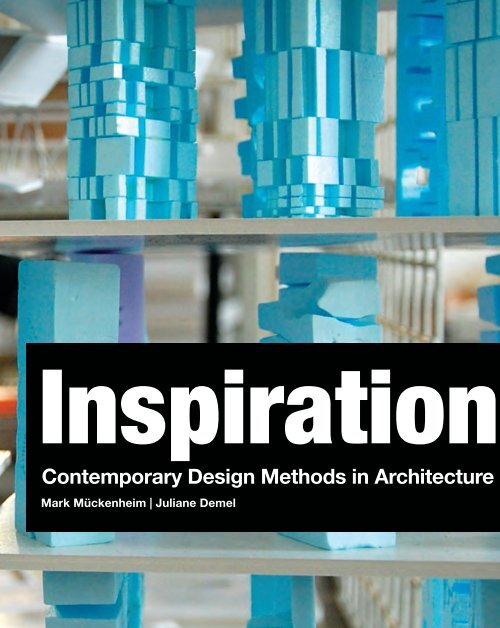

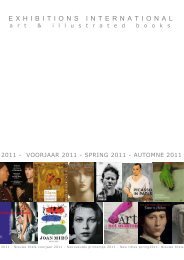

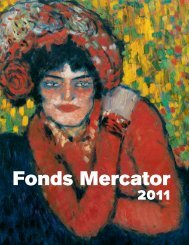

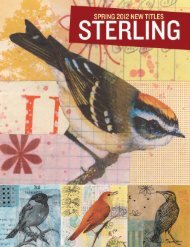
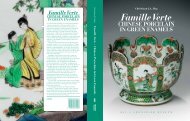
![01 -[BE/INT-2] 2 KOL +UITGEV+ - exhibitions international](https://img.yumpu.com/19621858/1/184x260/01-be-int-2-2-kol-uitgev-exhibitions-international.jpg?quality=85)






